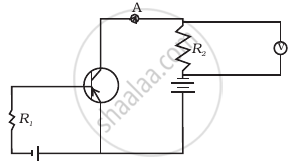Advertisements
Advertisements
प्रश्न
How can a photodiode be used to measure light intensity?
उत्तर
More photons are incident on the photodiode as the light's intensity rises. As a result, additional electron-hole pairs are generated. The photocurrent gets stronger. Thus, the photocurrent represents the intensity of the light.
APPEARS IN
संबंधित प्रश्न
With what considerations in view, a photodiode is fabricated? State its working with the help of a suitable diagram.
Even though the current in the forward bias is known to be more than in the reverse bias, yet the photodiode works in reverse bias. What is the reason?
A p-n photodiode is fabricated from a semiconductor with band gap of 2.8 eV. Can it detect a wavelength of 6000 nm?
Draw V − I characteristics of a p-n junction diode. Answer the following questions, giving reasons:
(i) Why is the current under reverse bias almost independent of the applied potential up to a critical voltage?
(ii) Why does the reverse current show a sudden increase at the critical voltage?
Name any semiconductor device which operates under the reverse bias in the breakdown region.
Explain the formation of depletion layer and potential barrier in a p−n junction.
Explain how a potential barrier is developed in a p-n junction diode.
What is the magnitude of the potential barrier across a Ge p-n junction?
Pressure P varies as P = `alpha/beta "exp" (- (alpha x)/"k"_"BT")`, where x denotes the distance, kB is the Boltzmann's constant, T is the absolute temperature and α and β are constant. The dimension of β is ______.
Which one of the following is not the advantage of LED?
In Figure, assuming the diodes to be ideal ______.

If the resistance R1 is increased (Figure), how will the readings of the ammeter and voltmeter change?

